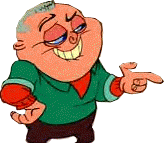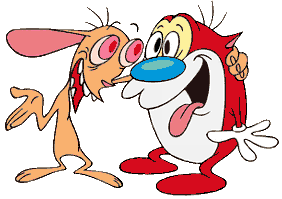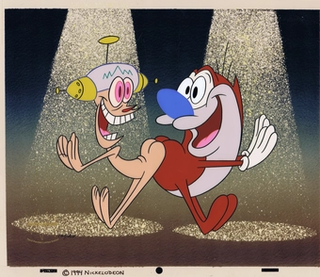
The Ren & Stimpy Show, commonly referred to as simply Ren & Stimpy, is an American comedy animated television series created by Canadian animator John Kricfalusi for Nickelodeon. Originally produced by Spümcø, the series aired on Nickelodeon from August 11, 1991, to December 16, 1995 with it’s last episode airing on MTV on October 20, 1996, spanning for a total of five seasons and 52 episodes. The series follows the misadventures of Ren Höek, an emotionally unstable and psychopathic chihuahua dog; and Stimpy, a good-natured and dimwitted Manx cat. It is the third cartoon to be aired of the original three Nickelodeon animated series known as "Nicktoons", alongside Doug and Rugrats, and is considered to be one of the progenitor series of the brand.

Spümcø, Inc. was an American animation studio that was active from 1989 to 2005 and based in Los Angeles, California. The studio was best known for working on the first two seasons of The Ren & Stimpy Show for Nickelodeon and for various commercials. The studio won several awards, including an Annie Award for Best Animated Short Subject for the music video of the song "I Miss You" by Björk.

Michael John Kricfalusi, known professionally as John K., is a Canadian former animator and voice actor, illustrator, and blogger. He is the creator of the animated television series The Ren & Stimpy Show, which was highly influential on televised animation during the 1990s. From 1989 to 1992, he was heavily involved with the first two seasons of the show in virtually every aspect of its production, including providing the voice of Ren Höek and other characters. In 2009, he won the Inkpot Award.

George Liquor is a cartoon character created by John Kricfalusi. Liquor is most famous for his appearances on The Ren & Stimpy Show. He is considered Kricfalusi's signature character and was a mascot for Kricfalusi's defunct animation studio, Spümcø. Kricfalusi portrayed George Liquor as a patriotic, outspoken, politically conservative blowhard. Kricfalusi described Liquor as his favorite character to animate.

Marland T. "Ren" Höek and Stimpson J. "Stimpy" Cat, created by John Kricfalusi, are the title characters in the Nickelodeon animated series The Ren & Stimpy Show, and its 2003 spin-off Ren & Stimpy "Adult Party Cartoon". Kricfalusi created the characters during his stay at Sheridan College and they first appeared on film in the pilot episode "Big House Blues". Ren is a scrawny, emotionally unstable, and sociopathic "Asthma Hound" Chihuahua, and his best friend Stimpy is a dim-witted, good-natured Manx cat. The show portrays their wacky, bizarre, and often surreal misadventures.
"A Visit to Anthony" is the penultimate episode of the second season of The Ren & Stimpy Show that aired on the Nickelodeon network on May 8, 1993.

The Royal Canadian Kilted Yaksmen is the season finale of the second season of The Ren & Stimpy Show that originally aired on Nickelodeon in the United States on 23 May 1993.
Robert Paul Jaques is a Canadian-American animator and animation director. He is best known for the television series The Ren & Stimpy Show, Ren & Stimpy "Adult Party Cartoon" and SpongeBob SquarePants. He also was nominated for two Emmys in 1992 and 1993 for his contributions to The Ren & Stimpy Show.
Fire Dogs is the 8th episode of The Ren & Stimpy Show of the first season of The Ren & Stimpy Show that originally aired on Nickelodeon in the United States on 29 September 1991.
Lynne Rae Naylor is a Canadian animator, artist, designer, director, and producer for television. She is best known for co-creating DreamWorks' The Mighty Ones, co-founding the animation studio Spümcø with John Kricfalusi, Bob Camp, and Jim Smith, and co-developing The Ren & Stimpy Show for Nickelodeon. She also worked on Batman: The Animated Series, The Powerpuff Girls, Samurai Jack, Super Robot Monkey Team Hyperforce Go!, Hi Hi Puffy AmiYumi, My Life as a Teenage Robot, and Wander Over Yonder.

"Stimpy's Invention" is the second segment of the sixth episode and season finale of the first season of The Ren & Stimpy Show, as well as the thirteenth aired segment overall. It originally aired on Nickelodeon in the United States on February 23, 1992. The episode follows Stimpy, who, after subjecting Ren to several failed inventions, invents one that takes control of its user's happiness in hopes of making Ren happier in life. However, the invention causes Ren to go insane.

Sven Höek is the 6th episode of the second season of The Ren & Stimpy Show that originally aired on Nickelodeon in the United States on 7 November 1992.

"Space Madness" is the 5th episode of the first season of The Ren & Stimpy Show. It originally aired on Nickelodeon in the United States on September 8, 1991. Along with Marooned and Black Hole, the episode is part of a loose trilogy in the first season known as the "space episodes" centering around the show-within-the-show, the Star Trek-like science fiction show The Adventures of Commander Höek and Cadet Stimpy.
Rubber Nipple Salesmen is the 5th episode of the second season of The Ren & Stimpy Show that originally aired on Nickelodeon in the United States on 29 August 1992.
Out West is the 4th episode of the second season of The Ren & Stimpy Show that originally aired on Nickelodeon in the United States on 29 August 1992.
The Boy Who Cried Rat! is the 6th episode of the first season of The Ren & Stimpy Show. It originally aired on Nickelodeon in the United States on September 8, 1991.
Stimpy's Big Day is the first episode of the first season of The Ren & Stimpy Show that originally aired on Nickelodeon in the United States on 11 August 1991.
The Big Shot! is the second episode of the first season of The Ren & Stimpy Show that originally aired on Nickelodeon in the United States on 11 August 1991.
Fake Dad is the 14th episode of the second season of The Ren & Stimpy Show that aired on the Nickelodeon network on 27 February 1993.
"Lair of the Lummox" is the season finale from the third season of The Ren & Stimpy Show. It originally aired on Nickelodeon in the United States on 30 July 1994.









